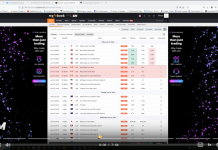 The FOMC met September 19 to 20 and announced that they would begin the normalization of their balance sheet in October. The FOMC left the target for the federal funds rate unchanged. Both of these policy decisions were fully anticipated. The FOMC released the update to its quarterly Summary of Economic Projections (SEP). Also, Chair Yellen gave her quarterly press conference and this press conference, like the policy statement, had little in the way of surprises.
The FOMC met September 19 to 20 and announced that they would begin the normalization of their balance sheet in October. The FOMC left the target for the federal funds rate unchanged. Both of these policy decisions were fully anticipated. The FOMC released the update to its quarterly Summary of Economic Projections (SEP). Also, Chair Yellen gave her quarterly press conference and this press conference, like the policy statement, had little in the way of surprises.
Although the unwind of the balance sheet was expected, there were probably a couple of participants who expressed wariness over the decision. For example, earlier in the Year, Neel Kashkari (Federal Reserve Bank of Minneapolis) dissented on the rate hike because he preferred to have a more complete plan for the unwind of the balance sheet. The FOMC had already decided that the normalization of the balance sheet would happen this year, but there may be additional news about the FOMC’s perceived tradeoff between the balance sheet unwind and future hikes in the federal funds rate. We do not anticipate any additional detail on the long-run framework for monetary policy or other indications about the terminal size of the balance sheet.
Inflation is the key topic
The Minutes to the July FOMC meeting revealed a wide-ranging discussion among the Committee about their framework for assessing inflation. The conclusion at that meeting appeared to be ongoing confidence in their outlook despite the fact that some of the persistent softness in inflation this year remained unexplained. Chair Yellen expressed that view in her post-FOMC press conference and other Fedspeak since the meeting has reiterated the view that they retain their outlook, but are somewhat puzzled. The Minutes to the September meeting will likely show this conversation to be ongoing within the Committee. There will be suggestions that low inflation may well be benign and there may be discussions of whether a different inflation target might be warranted. We are sceptical that a substantial fraction of the Committee embraced a material change in view. Nevertheless, this portion of the Minutes will be the crux. The discussion of the outlook for inflation would help explain the 0.1 percentage point reduction in the median projection of inflation for 2018. Of course, the meeting took place after the release of the August CPI report but before the August PCE report. The CPI report would have eased their concerns, whereas the PCE report shows other softness.
Financial conditions and financial stability
In the Minutes to two previous FOMC meetings, the FOMC discussed financial conditions and financial stability. These two issues are related but conceptually distinct. As was the case in the Minutes of the July meeting, the Minutes should show an array of views as to why financial conditions appear to be easing, on net, despite the series of rate hikes and the imminent unwind of the balance sheet. Do not expect consternation, rather the Minutes will likely highlight the FOMC’s view that easier financial conditions allow them to continue to hike, given their forecast for gradually rising inflation, without worrying about overtightening and committing a policy mistake.
Get more similar commentaries. Try out FxWatcher>>>
The Minutes will likely highlight that financial stability risks are a different concept. The FOMC will again note that financial stability risks stem from a potential sharp correction in asset prices against a backdrop of excessive leverage. In the past, the FOMC has not judged financial stability risks to be a serious issue. We anticipate a reiteration of that same view, albeit with a couple of participants again expressing some concern. The Minutes may discuss the fact that the FOMC does not have a clear view as to how adjustment in the short-term rate affects financial stability risks—on the one hand, higher short-term rates could curb excesses, on the other hand, a flatter yield curve (which would surely arise from aggressive tightening against a soft inflation background) could lead to more of a reach for yield.
The SEP showed minor updates
The September FOMC also had another quarterly release of the SEP. The projections for rate hikes (the dot plot) showed no change for 2017 and only a mild reduction in 2018 and 2019. The longer-run dot was reduced by 0.2 percentage point. This last point should garner some attention in the Minutes. The FOMC will likely note that, with a lower long-run neutral rate—the total amount of hiking that needs to be done is slightly less than previously thought. The Minutes may explain that the modest reduction in the 2018 and 2019 dots were a reflection of this view. There will likely also be a bit of discussion of the small overshooting of the neutral rate that is embodied in the dot plot.
The biggest potential risk is that there could be more discussion than we anticipate about a revision in the FOMC’s outlook for inflation. Yellen’s speech on 9/26 did not betray any shift in her outlook for inflation. But other speeches, including from Bill Dudley, suggest perhaps a touch more concern that low inflation will prove more persistent than previously anticipated.

















